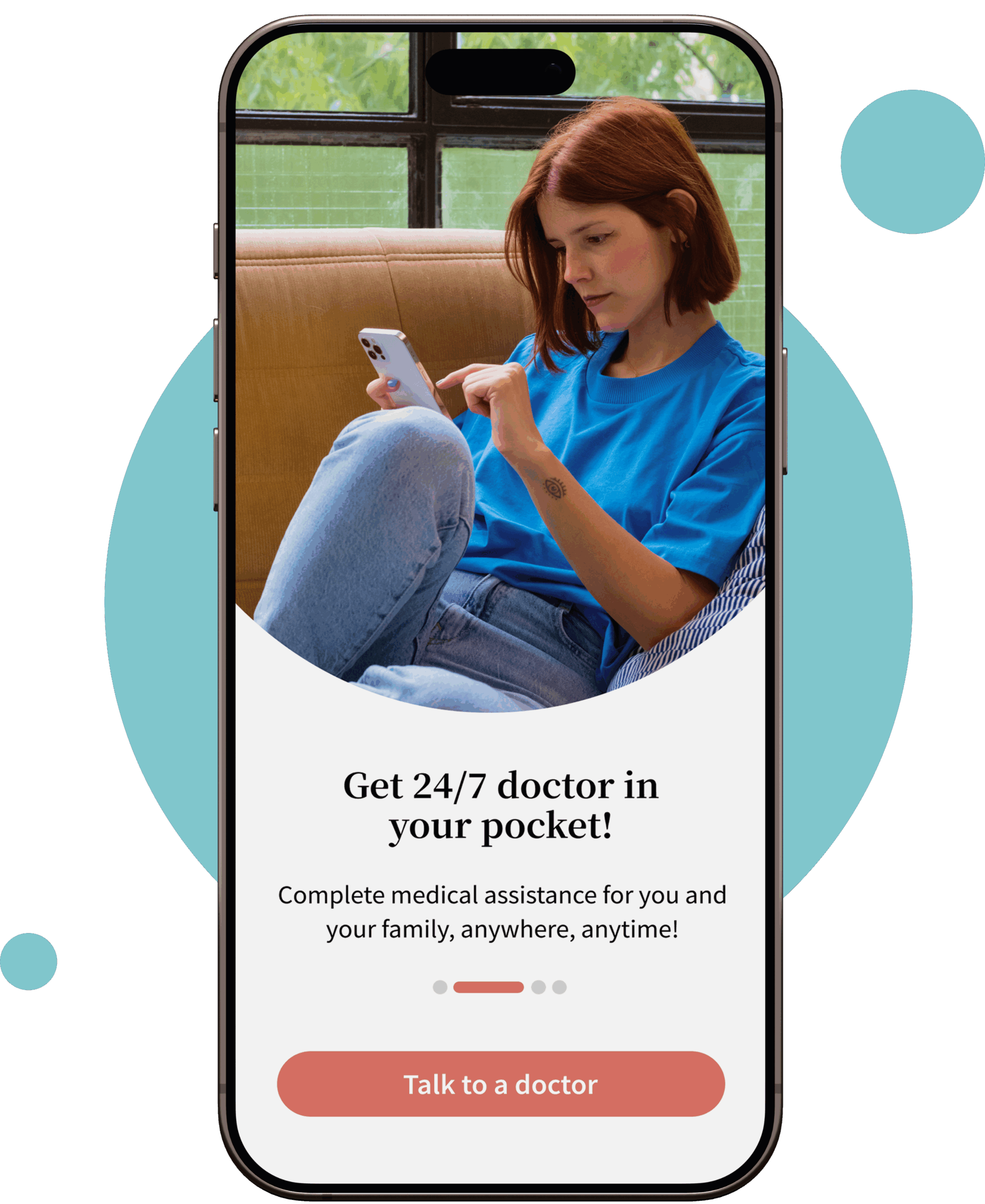
STDs treatment online and prescription
Sexually transmitted diseases can impact a person’s social life, mental health, and physical health. Treatment options for STDs (sexually transmitted diseases) are condition-specific. Sexually transmitted diseases (STDs) caused by bacteria or parasites, such as trichomoniasis, chlamydia, syphilis, and gonorrhea, are typically treated with antibiotics. Doctors often prescribe antiviral medications to improve symptoms and stop the progression of viral infections.
Get a prescription now from one of our doctors at Your Doctors Online. A prescription for STD will be sent to a pharmacy of your choice within minutes after evaluation and diagnosis.
Common medical conditions of STDs
Trichomoniasis
A sexually transmitted infection caused by the parasite Trichomonas vaginalis, characterized by itching, burning, and discharge in the genital area.
Gonorrhea
It is caused by the bacterium Neisseria gonorrhoeae, which can infect the urethra, cervix, rectum, and throat and, if untreated, cause complications.
Chlamydia
An STD caused by the bacterium Chlamydia trachomatis, often asymptomatic but can lead to serious reproductive health issues if left untreated.
Syphilis
It is caused by the bacterium Treponema pallidum, which progresses through stages if left untreated, causing severe health complications.
Genital Herpes
It is an STD caused by the herpes simplex virus, characterized by painful sores or blisters in the genital area.
Genital warts
An STD caused by a strain of human papillomavirus (HPV), causes the growth of flesh-colored bumps in genital area.
Ureaplasma
An infection caused by bacteria belonging to the genus Ureaplasma, which can cause urethritis, cervicitis, etc.
Balanitis
Inflammation of the foreskin and head of the penis, often caused by infection or irritation.
How do I know I have a STD or STI?
Common symptoms of sexually transmitted diseases (STDs) include:
- Abnormal bleeding, which may indicate a problem with the reproductive tract caused by a sexually transmitted infection.
- Sexually transmitted infections (STIs) like genital warts(HPV) can result in itching in the genital area.
- Burning or pain during urination, increased frequency of urination, or the presence of blood in the urine.
- Sores or rashes in the mouth or vaginal region, which may be signs of syphilis, herpes, or HPV.
- Abnormal vaginal discharge can occur in the case of chlamydia, gonorrhea, or trichomoniasis. The discharge can vary in color or consistency and often has a foul odor.
- Experiencing pain during sex. It is a symptom of pelvic inflammatory disease (PID), which is typically caused by advanced/untreated chlamydia or gonorrhea.
Causes of STD
Bacteria, viruses, and parasites are among the pathogens that can cause sexually transmitted diseases (STDs). Sexually transmitted diseases stem from:
- Bacteria: Sexually transmitted diseases caused by bacteria include syphilis, chlamydia, and gonorrhea. Sexual contact (oral, vaginal, or anal sex) and nonsexual methods (such as sharing needles or piercing equipment) are the main vectors for the transmission of these infections.
- Parasites: Parasites like trichomonas vaginalis and insects like scabies mites and crab lice are other potential causes of sexually transmitted diseases. Various infections can be caused by these parasites, which can be transmitted through sexual activity.
- Viruses: Some examples of viruses that can cause sexually transmitted diseases (STDs) are Herpes, HIV/AIDS, HPV, hepatitis B, CMV, and Zika. Sexual contact, sharing needles, and other forms of close contact are the main vectors for the transmission of these viruses.

Treatment of STD online
Treatment for specific STDs, include:
Chlamydia and gonorrhea, are treated with antibiotics, and it’s crucial to complete the full course of treatment to avoid complications.
- HIV/AIDS treatment focuses on antiretroviral drugs to control the virus, and early treatment is essential to manage the infection.
- Syphilis is treated with penicillin, early treatment is vital to prevent further organ damage.
- Genital warts can be treated with various methods like freezing, medication, or surgery, but the virus-causing warts remain in the body.
- Genital herpes has no cure, but antiviral medications can help manage outbreaks, and daily suppressive therapy can reduce recurrence.
STDs medication we prescribe
Antibiotic
Learn MoreANTIBIOTIC
Learn Moreantibiotic
Learn MoreANTIVIRAL
Learn MoreANTIVIRAL
Learn MoreANTIVIRAL
Learn Moreantifungal
Learn Moreantifungal
Learn Moreantifungal
Learn Moreantibiotic
Learn Moreantiparasitic
Learn MoreHow to connect with a doctor online?
Connect with a specialist online in 3 easy steps.
1
Describe your issue
Download our app, register and tell us about your medical issue to get started.
- STDs
- Allergies
- UTI
- Sexual Health
- Skin
- Covid
2
Chat with a doctor
Connect with a board-certified doctor. You can chat, send pictures and videos.
Hi I’m Dr. Nicole. How may I help you?
3
Get a prescription
Our online doctors can help you with your medical issues and give you prescriptions.
Prescription
- Valacyclovir 1000mg, take one tablet daily for 5 days
- OR 500 mg, twice daily for 3 days
Send Prescription
How can you prevent STDs?
It is important to follow medical advice, complete prescribed treatments, and inform sexual partners to prevent the spread of STDs. Regular testing, safe sex practices, and partner notification are crucial in managing and preventing STDs.
FAQS about STDs and STIs
Where can I get free std testing?
There are free or low-cost sexual health clinics offering free testing. However, if you need to discuss your symptoms with a doctor, connect with our online doctor for STDs.
Are STDs curable?
Most STD’s such as syphilis, gonorrhoea, chlamydia and trichomoniasis are entirely curable. So without further delay, connect with one of our online doctors and start STDs treatment online immediately.
What is anonymous std?
Anonymous STD tests is a way that ensures the confidentiality of results; the results are only shared with the private tester or the patient.
How to cure std without going to the doctor?
Unfortunately, there is no cure without getting the proper treatment or starting antibiotics; however, we have a solution for your problem. You can talk to an STD doctor online on our platform and get an STD prescription online immediately from your home.
When do symptoms of std start?
Symptoms of STDs vary for each disease. They usually appear within two weeks of infection, but they can appear much later. The occurrence of symptoms can depend on the specific STD. For example:
- After 2–6 weeks, you might start to feel symptoms of HIV, which include flu-like symptoms like fever, sore throat, headache, and aching muscles and joints.
- Symptoms of chlamydia typically don't show up for 1–3 weeks, but they can start much later.
- It may take 4–7 days for symptoms of genital herpes to emerge, and it may take months or even years after the initial exposure.
- Although symptoms of gonorrhea can manifest at any time after infection, they typically do so within two weeks. Syphilis symptoms usually appear after two to three weeks but can start earlier or much later.
- Trichomoniasis symptoms usually appear within four weeks but can start months later.
Will amoxicillin cure chlamydia?
No, amoxicillin is not the recommended treatment for chlamydia. Chlamydia is typically treated with antibiotics like azithromycin or doxycycline. However, it is one of the antibiotics that medical professionals advise using to treat chlamydia in pregnant women.
How long can STI stay in the body?
Sexually transmitted infections (STIs) can stay in the body for varying durations depending on the type of infection. There are about 20 different forms of STDs, many of which can go undetected for months, years, or even decades. Dormant STDs and STIs remind us of the value of sexual health testing because only a test can reveal the presence of an asymptomatic infection.
Can I get a chlamydia prescription online?
Yes, some online healthcare services may offer prescriptions for chlamydia treatment after an online consultation with a licensed healthcare provider. Our platform lets you communicate with a doctor and promptly receive a prescription online.
STIs that cause infertility
Untreated chlamydia and gonorrhoea can lead to infertility.
Can I get an antibiotic prescription online for STDs?
Yes, access to antibiotic prescriptions for chlamydia, gonorrhea, syphilis, and trichomoniasis, among other STDs, is possible through Your Doctors Online. The online platform makes it possible to get consultations and prescriptions for antibiotics. Your prescription for antibiotics will be delivered to your nearby pharmacy.
Do condoms prevent STDs?
Condoms are considered very effective in preventing most STI’s, although infections such as herpes can still be transmitted.
Which STDs that cause itching?
Chlamydia, gonorrhoea and trichomoniasis commonly cause itching.
What STD cannot be treated with antibiotics?
Antibiotics do not work against the HIV/AIDS virus, which is an STD. Although antiretroviral medications help people with HIV/AIDS. These medications help to manage their infection and keep viral loads in check, but the disease still has no known cure. Similarly, antibiotics do not work against Herpes.
Can I get STD antibiotics over the counter?
No, antibiotics for STDs are not available without a prescription. A doctor's prescription is required to obtain antibiotics for STDs like chlamydia, gonorrhea, syphilis, and others.
How soon would I know if I had an STD?
Although symptoms of a sexually transmitted disease (STD) may not appear for a long time, usually within two weeks of infection, you would know if you had one. When symptoms manifest might differ from one sexually transmitted disease to another. Genital herpes symptoms can manifest up to a year after infection, while those of chlamydia can take anywhere from one to three weeks.
The fact that some sexually transmitted diseases (STDs) do not manifest any symptoms in infected people is an essential point to remember. In order to detect and treat sexually transmitted diseases (STDs) early, regular testing and consulting a doctor are essential.
What STD is cured by doxycycline?
Several STDs, such as chlamydia and Mycoplasma genitalium, can be treated with Doxycycline. Oral antibiotic tablets such as Doxycycline or Azithromycin are typically prescribed for a short course to treat Chlamydia and M. genitalium. If there is known sensitivity to the antibiotic, Azithromycin can be replaced by Doxycycline.
What is the best antibiotic for STDs?
When treating sexually transmitted diseases (STDs), the most effective antibiotics are infection-specific. Common medications prescribed to treat various sexually transmitted diseases (STDs) include:
- Chlamydia: Azithromycin (Zithromax) or doxycycline (Vibramycin).
- Syphilis: Penicillin is the preferred treatment for syphilis.
- Trichomoniasis: Metronidazole or tinidazole are commonly used antibiotics
- Gonorrhea: Ceftriaxone (Rocephin) or azithromycin.
What are the STI symptoms in men?
STI symptoms in men are listed below: - Abnormal penile discharge - Genital, anal or oral sores - Burning and pain while urinating - Burning and itching of the penis
Related Blog Articles

Are hot flashes during pregnancy safe? What you need to know
Overview Pregnancy is a period of substantial physiological changes in mothers to provide birth and

What are the chances of getting pregnant from a precum?
Overview The question, “What are the chances of getting pregnant from precum?” is a common

Is PCOS Painful? Everything You Need to Know
Could you be one of the approximately 10 % of women who suffer from Polycystic
Get Started Today
Talk to online doctors now and get medical advice, online prescriptions, and referrals within minutes. On-demand healthcare services at your fingertips.



